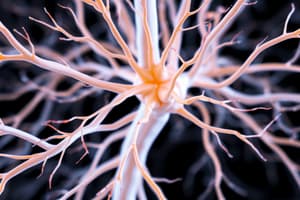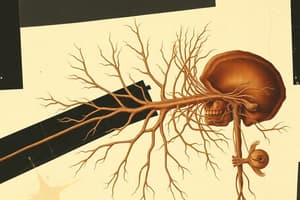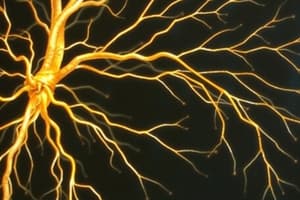Podcast
Questions and Answers
Which structure is primarily involved in innervating the anterior head region?
Which structure is primarily involved in innervating the anterior head region?
- Dorsal rami of cervical spinal nerves
- Trigeminal nerve (correct)
- Cervical plexus
- Vagus nerve
What is the role of pseudounipolar neurons in the peripheral nervous system?
What is the role of pseudounipolar neurons in the peripheral nervous system?
- They connect to the CNS and sensory receptors (correct)
- They form the cranial nerves
- They generate motor impulses
- They exclusively innervate skeletal muscles
Which spinal nerve function is accurately described as autonomic?
Which spinal nerve function is accurately described as autonomic?
- Anterior branches of cervical spinal nerves (correct)
- Dorsal rami of cervical spinal nerves
- Motor fibers innervating skeletal muscles
- Sensory fibers of spinal nerves
Dermatomes represent which aspect of spinal nerve function?
Dermatomes represent which aspect of spinal nerve function?
Which cranial nerve branch is responsible for innervating the green region of the head?
Which cranial nerve branch is responsible for innervating the green region of the head?
The vagus nerve primarily innervates which area?
The vagus nerve primarily innervates which area?
What is the primary function of motor fibers in the peripheral nervous system?
What is the primary function of motor fibers in the peripheral nervous system?
Which statement regarding cranial nerves is correct?
Which statement regarding cranial nerves is correct?
Which term best describes the network formed by the anterior branches of cervical nerves?
Which term best describes the network formed by the anterior branches of cervical nerves?
Which region does not receive innervation from the trigeminal nerve?
Which region does not receive innervation from the trigeminal nerve?
What is the total number of cervical spinal nerves?
What is the total number of cervical spinal nerves?
Which of the following statements about rami communicantes is true?
Which of the following statements about rami communicantes is true?
In which spinal region do the nerves change their naming convention to take the name of the vertebra above them?
In which spinal region do the nerves change their naming convention to take the name of the vertebra above them?
What is the primary function of the dorsal ramus?
What is the primary function of the dorsal ramus?
Which cranial nerve is responsible for motor innervation to the muscles of facial expression?
Which cranial nerve is responsible for motor innervation to the muscles of facial expression?
What distinguishes spinal nerves from cranial nerves in terms of their structure?
What distinguishes spinal nerves from cranial nerves in terms of their structure?
Which plexus is responsible for innervating the lower limbs?
Which plexus is responsible for innervating the lower limbs?
Which region of the spinal cord does NOT form a nerve plexus?
Which region of the spinal cord does NOT form a nerve plexus?
What category do spinal nerves fall under regarding their function?
What category do spinal nerves fall under regarding their function?
What do the ventral rami primarily supply?
What do the ventral rami primarily supply?
Which muscles are innervated by the femoral nerve?
Which muscles are innervated by the femoral nerve?
What is the primary motor function of the tibial portion of the sciatic nerve?
What is the primary motor function of the tibial portion of the sciatic nerve?
Which nerve has only sensory functions and innervates the skin on the posterior surface of the thigh and leg?
Which nerve has only sensory functions and innervates the skin on the posterior surface of the thigh and leg?
Which nerve innervates the external anal sphincter and external urethral sphincter?
Which nerve innervates the external anal sphincter and external urethral sphincter?
What is the primary function of the coccygeal plexus?
What is the primary function of the coccygeal plexus?
How do motor units differ depending on the muscles they serve?
How do motor units differ depending on the muscles they serve?
Which nerve is responsible for innervating the anterior thigh and medial leg skin?
Which nerve is responsible for innervating the anterior thigh and medial leg skin?
What type of functions do the superior and inferior gluteal nerves have?
What type of functions do the superior and inferior gluteal nerves have?
Which portion of the sciatic nerve is responsible for innervating the anterior compartment of the leg?
Which portion of the sciatic nerve is responsible for innervating the anterior compartment of the leg?
What characterizes the neuromuscular junction (NMJ)?
What characterizes the neuromuscular junction (NMJ)?
What is the primary function of the cervical plexus?
What is the primary function of the cervical plexus?
What defines the brachial plexus's serious role in orthopedics?
What defines the brachial plexus's serious role in orthopedics?
Which nerve is primarily responsible for the flexion of the forearm?
Which nerve is primarily responsible for the flexion of the forearm?
What is a significant characteristic of thoracic nerves compared to other plexuses?
What is a significant characteristic of thoracic nerves compared to other plexuses?
Which nerve originates from the lumbar plexus and is deemed most important?
Which nerve originates from the lumbar plexus and is deemed most important?
What is the role of the median nerve in the hand's motor function?
What is the role of the median nerve in the hand's motor function?
What type of nerves are intercostal nerves classified as?
What type of nerves are intercostal nerves classified as?
Which of the following correctly describes the role of the ulnar nerve?
Which of the following correctly describes the role of the ulnar nerve?
What is a defining feature of the brachial plexus's structure?
What is a defining feature of the brachial plexus's structure?
What sensory function does the radial nerve provide?
What sensory function does the radial nerve provide?
Which muscle is NOT innervated by the femoral nerve?
Which muscle is NOT innervated by the femoral nerve?
What is the primary role of the posterior femoral cutaneous nerve?
What is the primary role of the posterior femoral cutaneous nerve?
Which of the following statements about the sciatic nerve is true?
Which of the following statements about the sciatic nerve is true?
Which component of the sciatic nerve innervates the short head of biceps femoris?
Which component of the sciatic nerve innervates the short head of biceps femoris?
What is the function of the pudendal nerve?
What is the function of the pudendal nerve?
Which nerve serves exclusively motor functions to the posterior pelvis?
Which nerve serves exclusively motor functions to the posterior pelvis?
What determines the size of a motor unit?
What determines the size of a motor unit?
Which area is primarily innervated by the tibial nerve?
Which area is primarily innervated by the tibial nerve?
What is unique about the coccygeal plexus?
What is unique about the coccygeal plexus?
Which statement about the neuromuscular junction (NMJ) is accurate?
Which statement about the neuromuscular junction (NMJ) is accurate?
Flashcards are hidden until you start studying
Study Notes
Peripheral Nervous System (PNS) and the Local Motor System
- The locomotor system operates in conjunction with the PNS, essential for movement.
- Peripheral nerve lesions are common in traumatology due to their proximity to joints, muscles, and bones.
- PNS is categorized into autonomic and somatic nervous systems.
- Sensory fibers in the somatic system consist of pseudounipolar neurons in spinal ganglia, connecting periphery to the CNS.
- Motor fibers originate in the CNS, projecting through peripheral nerves to innervate skeletal muscles.
Types of Nerves
- Cranial Nerves:
- Originate in the brain, innervating the head, neck, and back.
- Not all are purely somatic; examples include autonomic nerves such as oculomotor (III), facial (VII), vagus (X), and glossopharyngeal (IX).
- Spinal Nerves:
- Arise from the spinal cord, innervating the neck, trunk, and limbs; can be autonomic or somatic.
- There are 31 pairs: 8 cervical, 12 thoracic, 5 lumbar, 5 sacral, and 1 coccygeal.
- Dermatomes represent specific body regions innervated by each spinal nerve.
Innervation of the Head
- The trigeminal nerve (V cranial) provides primary innervation for the anterior head, divided into three branches:
- Ophthalmic: Green region.
- Maxillary: Blue region.
- Mandibular: Red region.
- The posterior head and ear regions are innervated by cervical spinal nerves' dorsal rami.
- The cervical plexus, formed by the anterior cervical nerves, innervates the neck (purple region).
Spinal Nerve Structure
- Spinal nerves split into dorsal and ventral roots:
- Dorsal Root: Contains sensory neuron bodies in spinal ganglia.
- Ventral Root: Contains motor neurons.
- Upon exiting the vertebral column, spinal nerves form mixed nerves with sensory and motor fibers.
Communication and Rami
- Rami communicantes link spinal nerves and sympathetic trunk ganlgia:
- Gray Ramus Communicans: Carries postganglionic fibers to effector organs.
- White Ramus Communicans: Transmits preganglionic fibers to sympathetic ganglia.
Nerve Plexuses
- Ventral rami form nerve plexuses instead of running independently:
- Cervical Plexus: Innervates the head, neck, and shoulders.
- Brachial Plexus: Innervates chest, shoulders, arms, and hands.
- Lumbar Plexus: Innervates back, abdomen, groin, and legs.
- Sacral Plexus: Innervates pelvis, legs, and feet.
- Coccygeal Plexus: Innervates the coccygeal region.
Cervical Plexus
- Formed from spinal nerves C1-C5, provides motor and sensory branches.
- Key nerves include the phrenic nerve, innervating the diaphragm, and various cutaneous branches.
Brachial Plexus
- Formed by C5-T1 spinal nerves, crucial for upper limb function.
- Divided into trunks, divisions, cords, and terminal branches, including:
- Musculocutaneous Nerve: Innervates arm flexors.
- Median Nerve: Controls forearm and hand flexors.
- Radial Nerve: Innervates forearm extensors.
- Ulnar Nerve: Innervates hand muscles.
Lumbar Plexus
- Originates from L1-L4 spinal nerves.
- Key nerves include the femoral nerve (innervates anterior thigh) and obturator nerve (innervates medial thigh).
Sacral Plexus
- Derived from L4-S3 spinal nerves, with the sciatic nerve being the largest.
- Innervates lower limbs with separate tibial and common fibular portions.
Coccygeal Plexus
- A small plexus formed by S4 and coccygeal nerves, innervating anal region muscles.
Neuromuscular Junction (NMJ)
- Site of synapse between motor neuron and muscle fiber, facilitating muscle contraction.
- Motor units consist of one motor neuron and all muscle fibers it controls.
- The size of motor units varies depending on the required precision of movement; larger in back muscles, smaller in eye muscles to allow fine control.
Studying That Suits You
Use AI to generate personalized quizzes and flashcards to suit your learning preferences.




